
Identifying the most common weeds in Wisconsin, such as pigweed and purslane, is crucial for maintaining a healthy lawn. Luckily, this article provides useful tips, such as using mulch and herbicides, so you can take action against them.
Whether you’re battling dandelions in Milwaukee or tackling thistles in Madison, we’ll help you understand why these weeds thrive and how to keep them from taking over your green spaces.
Common Wisconsin Broadleaf Weeds
Broadleaf weeds are characterized by their wide leaves, which generally feature a prominent central vein. These weeds exhibit a wide range of appearances and can differ a lot from one species to another in terms of root systems. Here are the most common broadleaf weeds in Wisconsin:
1. Redroot Pigweed (Amaranthus retroflexus)

Redroot pigweed, as its name suggests, is easily identifiable by its red taproot. This weed is part of the amaranth family and is known for its adaptability in various environments across Wisconsin. One of the most challenging aspects of controlling pigweed plants is that they develop resistance to common herbicides, so they often survive treatments.
- Life cycle: Summer annual
- Weed type: Broadleaf
- Where it thrives: Prefers full sun and moist, neutral soils, but can grow in clay, loam, and sand
- How to identify common pigweed: Egg-shaped leaves with a notch or indentation at the tip and dense, small hairs along the stem
- How to get rid of common pigweed: Easier to control with herbicides than other pigweed species, but can be herbicide-resistant. Can be prevented with cultural practices, like tilling, or hand-pulled individually.
2. Dandelion (Taraxacum officinale)

Dandelions are one of the most recognizable weeds found in Wisconsin. These plants can grow almost anywhere, seemingly overnight, and are not particular about soil conditions. One tricky aspect about dandelions is that if even a small segment of their taproot is left in the soil during removal, it can regrow.
On a positive and curious note, there are some benefits to the dandelion. Every part of the plant, from the flower to the roots, is edible (just make sure the plant hasn’t been treated with chemicals if you plan on eating it).
- Life cycle: Winter perennial
- Weed type: Broadleaf
- Where it thrives: Can tolerate a wide variety of soils, but prefers soils with low calcium and high levels of nitrogen and potassium. Can indicate acidic soil conditions.
- How to identify dandelion: Bright yellow flowers that bloom in April. Produces a seed head in the form of a puffball. Long serrated leaves that point back to the center of the rosette.
- How to get rid of dandelion: Dig out as much of the taproot as possible in early spring. You can combine the treatment with a spring pre-emergent herbicide application to avoid the establishment of new weeds since dandelions can regenerate from fragments of roots. You can also use a broadleaf post-emergent herbicide during fall, which is generally more effective on perennials.
3. Purslane (Portulaca oleracea)

If you’re noticing a plant that resembles a succulent growing in your yard, you might be looking at purslane. This fast-growing weed has succulent leaves and stems that store water, allowing it to thrive in various conditions. Purslane grows close to the ground, often forming a mat.
This is also an edible weed (and a highly nutritious one). It is a rich source of omega-3 fatty acids and vitamins A and C, among other nutrients.
- Life cycle: Summer annual
- Weed type: Broadleaf
- Where it thrives: Prefers full sun. Adapts to a variety of soils, including poor, compacted ones. They might also indicate your soil has good drainage and is fertile.
- How to identify purslane: The stems have a red-brownish color that contrasts with the shiny green leaves in the form of wedges and bright yellow flowers.
- How to get rid of purslane: Hand-pulling or spot-treating while still young can be an option when dealing with a small infestation. Purslane also doesn’t tolerate traffic or shade.
4. Common Ragweed (Ambrosia artemisiifolia)

Common ragweed is notorious for thriving in disturbed soils and tolerating poor growing conditions, making it a frequent sight in urban and rural areas of Wisconsin. This weed is also a major cause of seasonal allergies.
While common ragweed is relatively easy to control with herbicides, it is advisable to switch the type of herbicide used from year to year so it doesn’t build up tolerance.
- Life cycle: Summer annual
- Weed type: Broadleaf
- Where it thrives: Thrives in full sun and poor soils
- How to identify ragweed: The stems are hairy and branched, reaching up to 6 feet tall. Fern-like, compound leaves are also covered in fine hairs.
- How to get rid of ragweed: Easy to control with pre-emergent or post-emergent herbicide applications.
5. Common Lambsquarters (Chenopodium album)

Common lambsquarters is a weed that can reach heights of 3 to 4 feet and features a white mealy coating. This weed is notorious for its competitive nature, particularly in agricultural settings. In crop fields, lambsquarters presence can lead to significant economic impacts, with potential yield losses ranging from 25 to 48%.
- Life cycle: Summer annual
- Weed type: Broadleaf
- Where it thrives: Prefers rich soils, full sun, and loam
- How to identify common lambsquarters: The plant has a white mealy coating. The first two leaves are opposite, with parallel edges and rounded tips. Mature plants have alternate leaves with toothed edges and clustered spikes of green flowers.
- How to get rid of common lambsquarters: Hand-pull plants at the early stages of life. You can also cover them with mulch or black plastic paper. Larger populations and mature plants will need post-emergent herbicides (they are resistant to the ones in the triazine and ALS-inhibitor families).
6. Bull Thistle (Cirsium vulgare)
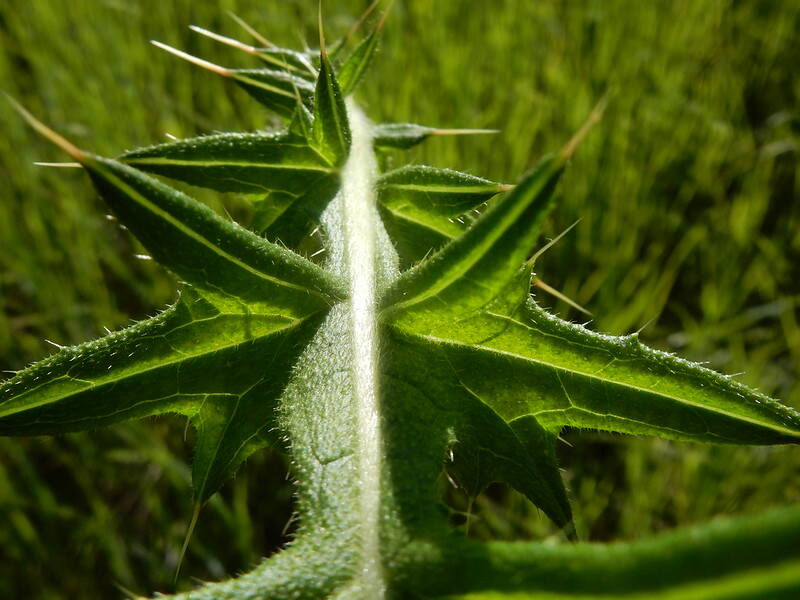
Bull thistle, known for its spike appearance, carries a legendary status in Scottish folklore. It is said to have played a role in the defense against Norse invaders when they stepped on the plant, causing them to cry out in pain and alerting Scottish clansmen. This plant is also Scotland’s national flower.
However, bull thistles can be unsightly in Wisconsin lawns. So, unless you have plans that involve repelling Norsemen, you might find it advisable to remove these spiky invaders.
- Life cycle: Biennial
- Weed type: Broadleaf
- Where it thrives: Prefers nitrogen-rich soils; full sun to partial shade
- How to identify bull thistle: The branches have green or brown spines; the leaves are hairy; the flowers are dark pink to purple
- How to get rid of bull thistle: Hand-pull young plants before they go to seed. Till the soil to reduce the number of plants. For large infestations, apply post-emergent herbicides containing aminopyralid, 2,4-D, or dicamba.
7. Canada Thistle (Cirsium arvense)
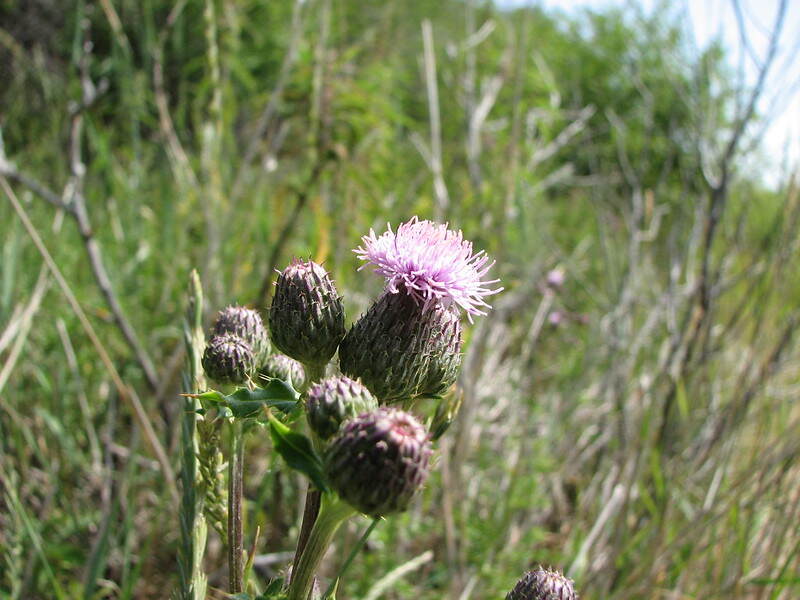
The Canada thistle is often confused with bull thistle, but it’s crucial to differentiate between them as their control methods differ significantly. Unlike the bull thistle, Canada thistle does not have spiny stems or flowers.
Importantly, while tilling the soil can be an effective method for managing bull thistle, this approach should not be used for Canada thistle. Tilling can increase the spread of this weed, as its root system can regenerate from even small fragments left in the soil.
- Life cycle: Perennial
- Weed type: Broadleaf
- Where it thrives: Full sun and moist soils
- How to identify Canada thistle: Lance-shaped leaves with wavy edges and yellowish prickles; teardrop-shaped pink and purple flowers
- How to get rid of Canada thistle: Applying pre-emergent herbicides in spring is crucial. Mow down or cut stands before they flower, and avoid tilling to prevent the spread of the plant’s rhizomes. For larger infestations, apply post-emergent herbicides.
8. Velvetleaf (Abutilon theophrasti)

Velvetleaf is a highly competitive weed predominantly found in agricultural fields but can also be found in gardens, particularly in southern Wisconsin. This weed’s name derives from its unique leaves, which are covered in short, fine hairs, which give them a soft, velvety texture.
- Life cycle: Summer annual
- Weed type: Broadleaf
- Where it thrives: Prefers full sun and fertile loam or clay-loam
- How to identify velvetleaf: Leaves are heart-shaped, with toothed margins and short hairs on both sides. All plant parts have a bad odor when crushed.
- How to get rid of velvetleaf: Hand-pull plants before they bloom. If they are still small, you can also mow them on the lowest setting. Do not till or plow the soil. Alternatively, apply post-emergent herbicides containing 2,4-D when plants are less than 4 inches tall.
9. Pennsylvania Smartweed (Polygonum pensylvanicum)
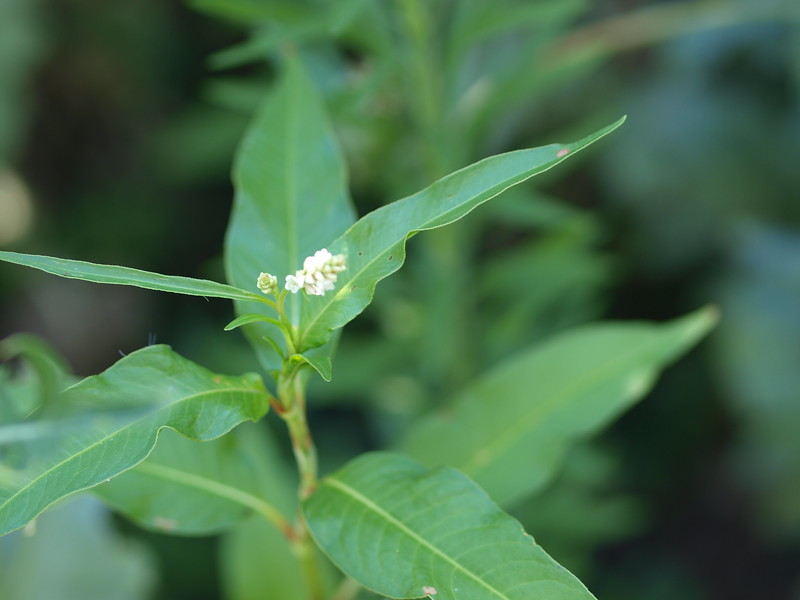
Pennsylvania smartweed, often mistaken for its close relative, Lady’s thumb, can be identified by the absence of hairs along its stem — a key feature that differentiates it from its counterpart. Luckily, despite their minor differences in appearance, Pennsylvania smartweed and Lady’s thumb are managed similarly, with applications of pre- and post-emergent herbicides.
- Life cycle: Summer annual
- Weed type: Broadleaf
- Where it thrives: Wet, poorly drained soils, high in nitrogen and phosphorus. Does not tolerate drought.
- How to identify Pennsylvania smartweed: Flowers are inch-long spikes, light pink in color. Leaves have smooth edges and are lanceolate. Does not have hairs along the stem.
- How to get rid of Pennsylvania smartweed: Hand-pull, hoe, or dig out new plants, making an effort to try to remove all of the underground rhizomes and rooting points. The applications of pre-emergent herbicides in spring and spot-treating with post-emergent herbicides is also helpful.
10. Horseweed (Conyza canadensis)

Horseweed, also known as marestail, is a widespread weed found in almost every county in Wisconsin, with the exception of Pierce County. It typically establishes itself in undisturbed areas with a significant amount of bare ground, such as fields, roadsides, and waste areas.
One of the most challenging aspects of controlling horseweed is its ability to resist herbicides containing glyphosate, one of the most common chemicals in herbicides.
- Life cycle: Winter or summer annual
- Weed type: Broadleaf
- Where it thrives: Full sun, undisturbed areas
- How to identify horseweed: Leaves are narrow to oval, with coarse hairs. The margins can be smooth or toothed, becoming narrower towards the top of the plant. The stem is also covered with hairs. Flowers are urn-shaped.
- How to get rid of horseweed: Make sure you hand-pull the plants before they go to seed, and till the soil afterward.
Common Wisconsin Grass and Grass-Like Weeds
Grass and grass-like weeds are the weeds that blend seamlessly into lawns and fields, often going unnoticed until they’ve firmly established themselves. Here are the most common grass and grass-like weeds in Wisconsin:
1. Crabgrass (Digitaria ischaemum)
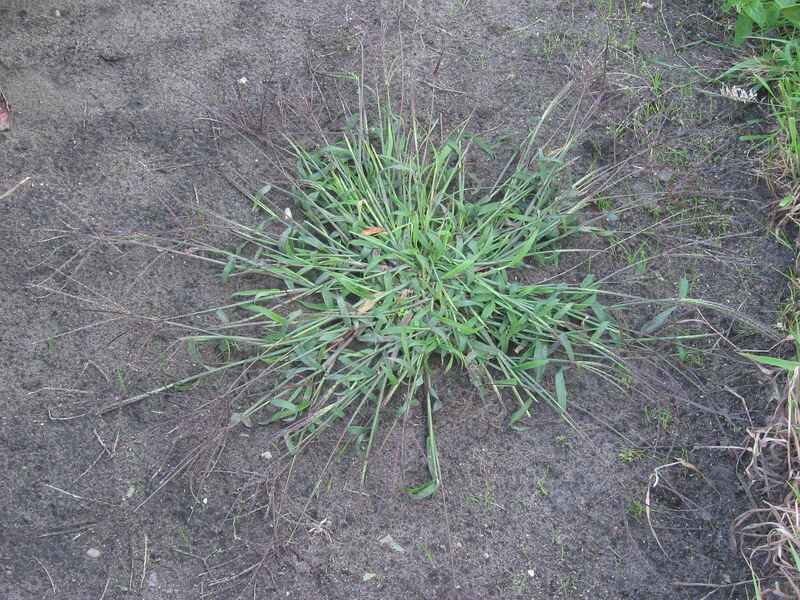
Crabgrass is arguably the most common grassy weed throughout the United States, including Wisconsin. This invasive weed can quickly take over lawns if left untreated, crowding out desirable turfgrass with its aggressive growth.
Prevention is the best strategy to get rid of crabgrass. This includes applying pre-emergent herbicides at the correct time for your area and maintaining proper lawn care practices so your turf can become thick and healthy, outcompeting weeds.
- Life cycle: Summer annual
- Weed type: Grass
- Where it thrives: Prefers heavier soil types but tolerates a variety of conditions: heat, drought, full sun, and partial shade. It is killed by frost. It can also be indicative of excess nitrogen in your lawn.
- How to identify crabgrass: Light green colored, this weed has noticeable nodes from which the leaves grow in a zig-zag pattern.
- How to get rid of crabgrass: Mowing your lawn higher and fertilizing it with nitrogen will increase the crabgrass’s competition. Mulching your grass clippings can also slow the germination process since crabgrass seeds must have light to germinate. The plant hugs the ground as it grows, making it hard to hand-pull once established.
2. Yellow Nutsedge (Cyperus esculentus)
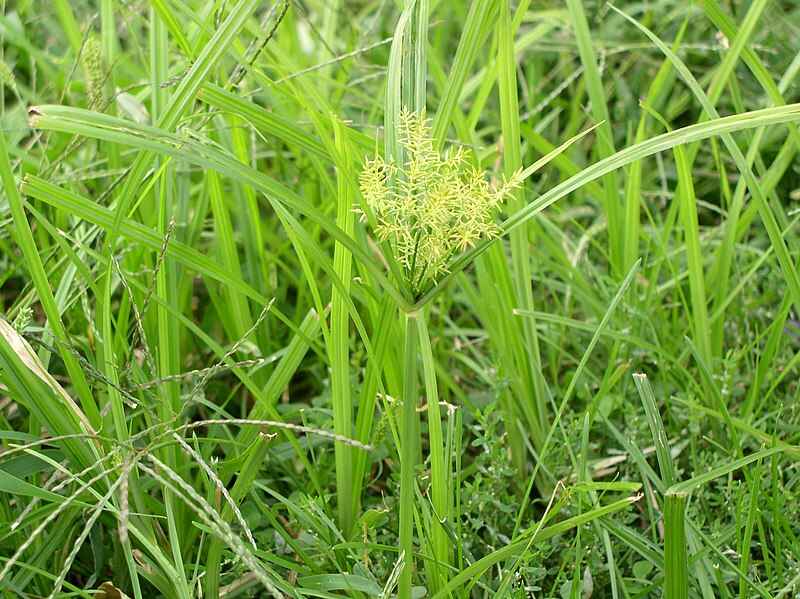
Yellow nutsedge is an aggressive weed that thrives during the heat of the summer, a time when the cool-season turfgrasses common in Wisconsin are growing more slowly and are less competitive.
This weed is particularly difficult to control because it spreads through an extensive underground system of tubers, which can survive in dormancy even during Wisconsin’s harsh winters.
- Life cycle: Perennial
- Weed type: Sedge
- Where it thrives: Grows best in wet areas with full sun exposure but can adapt to various conditions. It is often an indicator of excess watering or poor soil drainage.
- How to identify nutsedge: Long, light green or yellow leaves with a glossy appearance. As typically found in sedges, a triangular stem is a key feature when differentiating from other grassy weeds. The flowers bloom at the end of the branches in the form of yellow spikelets.
- How to get rid of nutsedge: Nutsedge can be hand-pulled, but be sure to remove all the underground tubers and rhizomes. This weed type is best controlled with post-emergent herbicide applications. Selective herbicides are only effective when applied on actively growing plants.
3. Quackgrass (Elytrigia repens)
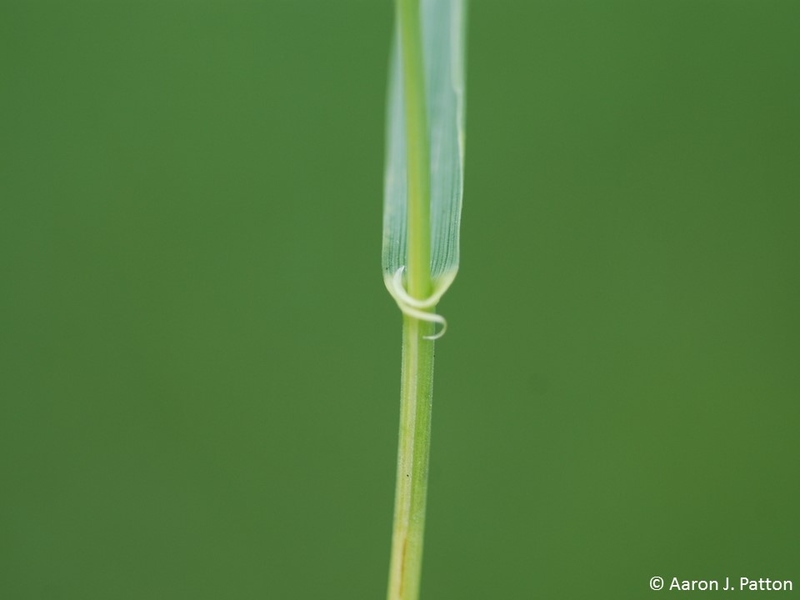
Quackgrass is a cool-season perennial grass that invades gardens, lawns, crop fields, roadsides, and any other disturbed, moist area throughout Wisconsin. This grassy weed can often be mistaken for tall fescue due to its similar appearance; however, a distinctive feature of quackgrass is its distinct auricles, which are not present in tall fescue.
Quackgrass thrives particularly well in environments where the existing grass is weak and unhealthy, capitalizing on the lack of competition to establish itself firmly.
- Life cycle: Perennial
- Weed type: Grass
- Where it thrives: Well-drained, moist, slightly acidic soils
- How to identify quackgrass: Leaves wrap around the stem forming claw-like appendages (auricles). Leaves and stems can be hairy, but it varies. Flowers are long spikes with spikelets arranged in two rows.
- How to get rid of quackgrass: Hand-pulling can be effective if you only have a few small patches, but make sure to remove all rhizomes from the soil. Apply pre-emergent and post-emergent non-selective herbicides, like Roundup, to kill it, but be careful as this will also kill your grass.
4. Giant Foxtail (Setaria faberi)

Giant foxtail is one of three foxtail species found in Wisconsin, alongside its cousins, yellow foxtail and green foxtail. These weeds are named after their inflorescences, which are bristly and spike-like panicles, resembling the bushy tail of a fox. These weeds are known for their resilience and can produce a significant number of seeds, contributing to their spread.
- Life cycle: Summer annual
- Weed type: Grass
- Where it thrives: Sandy to loamy soil; tolerates compacted soil
- How to identify yellow foxtail: Grows up to 4 feet tall. Leaves are light green and floppy. Seed heads are spiked and look like a fox’s tail.
- How to get rid of yellow foxtail: Mow the plant early in spring before seed heads form. Pre-emergent herbicides should also be applied in spring. Spot treatment with post-emergent herbicides is recommended, but more than one application might be necessary.
FAQ About Lawn Care in Wisconsin
When Do I Apply Pre-Emergent Herbicides in Wisconsin?
Weed control should be part of your spring lawn care routine in Wisconsin. The optimal time to apply pre-emergent herbicides is when soil temperatures consistently range between 50 and 55 degrees Fahrenheit. Typically, this condition is met between April 20th and April 28th in Madison, but the exact timing can vary depending on your specific location in the state.
When Do I Fertilize My Lawn in Wisconsin?
Fertilizing should be a fall lawn care task for your Wisconsin lawn. This is when cool-season grasses, the most common in the state, are in their growing season, so fertilizing during this time will support vigorous growth and root development. Aim to fertilize during early fall, around Labor Day.
What are the Best Grass Types for Wisconsin?
The most suitable grass types for Wisconsin’s climate are cool-season grasses, which thrive in the cooler temperatures of the state. Here are the top choices for Wisconsin lawns and our helpful guides about them:
- Guide to Growing Kentucky Bluegrass
- Guide to Growing Perennial Ryegrass
- Tall Fescue Lawn Maintenance Guide
- Guide to Growing Fine fescues
When to Call a Professional
Handling invasive weeds in Wisconsin is no small feat. While this guide offers insights into identifying and managing common weeds, the task can quickly become overwhelming as these resilient invaders take root. Consider calling a lawn care pro near you before the weeds take over your lawn.
Main Image Credit: Rudolphous / Wikimedia Commons / CC BY-SA 4.0